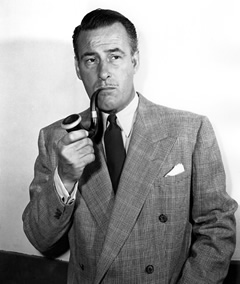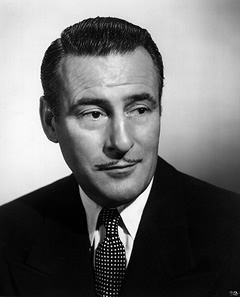SPOTLIGHT ARTICLE
TOM CONWAY:
The Man Who Couldn't Get A Break
By Elizabeth McLeod
It's never easy to be the successor to a legend. Expectations naturally run high, and unless you're the sort to become a legend yourself, no matter how good you are at what you do, you'll always be compared to those who came before. It's hard enough to replace a legend once. But, imagine doing it over and over and over again…imagine that being the definitive thread of your whole career. That's how it was for Tom Conway who, for all his own merits as a performer, seems destined to be remembered as "the actor who replaced ______."
Tom Conway started life as Thomas Charles Sanders, born in St. Petersburg, Russia in 1904 to British parents (the head of a rope manufacturing firm and his horticulturalist wife). The family, which by then included younger brother George and a sister, Margaret, returned to their homeland just ahead of the Bolshevik revolution, and the boys grew up in comfortable middle-class circumstances. Young George Sanders quickly overshadowed his older brother, finding stardom first on the stage and on film, building a successful career specializing in the portrayal of glossy, well-groomed cads. Tom Sanders had left England behind to try his hand as a miner in Rhodesia and as a rancher in South Africa, only to end up broke and alone in an unfamiliar land. Borrowing the money for the voyage back to England, Tom worked odd jobs in manufacturing and in sales, even as George Sanders was a rising name in filmdom. With few other prospects before him, Tom Sanders decided to give acting a try himself.
 Tom Conway Tom Conway |
Stock-company stage roles soon led to bit roles in BBC dramas, and gave Tom Sanders confidence that he could stand on his own as a performer. George had moved on to Hollywood by this time, and casting an envious eye across the ocean, Tom decided to join him there in 1940, changing his surname to "Conway" to avoid confusion. He landed first at MGM, making his stateside film debut in a supporting role in a Nick Carter B-picture with Walter Pidgeon. As George moved on to flashy roles in A-pictures, Tom continued to work the lower-budget side of the studio street, first at MGM and then at RKO, where he attracted notice as a supporting player in a string of offbeat horror pictures directed by Val Lewton. He also got a chance at a starring role…thanks to his younger brother.
George Sanders had been supplementing his A-picture career by starring in a series of B-films based on the debonair private eye known as "The Falcon," but grew tired of the series after three installments and suggested his brother as a potential replacement. Sanders and Conway appeared together in The Falcon’s Brother in 1942, and the picture was successful enough for the series to continue with Conway in the lead for nine more entries.
It was on the strength of his performance in the Falcon films that Conway was tapped to replace his first radio legend. After seven years as Sherlock Holmes on screen and on the air, Basil Rathbone announced his plans to leave that role at the end of the 1945-46 season -- and Tom Conway was announced as his replacement when the program returned to the air in the fall. Conway was selected because his voice sounded much like Rathbone's, and he did a credible job in the role -- he would be remembered as a fine Holmes today had not the long shadow of Rathbone obscured his work. His approach to the part mirrored Rathbone's -- the cerebral man of action who chose his words carefully and seemed to relish the puzzle as much as he relished the solution. But, Conway's Holmes seemed subtler in his dealings with Watson, less harsh in his criticism of his associate's failure to grasp a key point in the case at hand. Perhaps this bit of deference was worked into the performance to satisfy Nigel Bruce, who had frequently expressed frustration at the buffoonish, bumbling way that Watson was portrayed on film, but it also fit in well with Conan Doyle's original concept of the character -- Watson was supposed to be an intelligent man, who seemed slow only by comparison with Holmes' razor-quick mind. The on-mike relationship between Conway and Bruce during their one season together effectively captured this dynamic.
But, all was not sanguine backstage. Nigel Bruce had been enticed to remain for another season only by the promise of more money and star billing, which put Tom Conway second in the credits even though he played the lead character. The production team was in chaos, with award-winning scriptwriters Anthony Boucher and Denis Green feuding constantly with new producer Tom McKnight, whom they characterized as a "pretentious and arrogant boor." Amidst constant strife, the series pushed onward to the end of the season, but Nigel Bruce had had enough, and so had Tom Conway. What could have been the role of a lifetime for Conway came to an unpleasant end for all concerned. When the Holmes series resumed in the fall, it did so from New York, with a new production team and an entirely new cast...
(READ THE REST OF THIS ARTICLE BELOW)
|
Featured Radio Collections
|

From the fog-shrouded streets of Victorian London come 16 intriguing episodes, starring Tom Conway as Holmes and Nigel Bruce as Watson, in scripts by mystery legends Denis Green, Anthony Boucher, and more! Based on the works of Sir Arthur Conan Doyle, these capers of curious clues hidden in plain sight feature performances by Peggy Weber, Gale Gordon, Jay Novello, Gavin Gordon, Frederick Worlock, Mary Gordon, and more.
16 Episodes on 8 Audio CDs.

|
 MORE DETAILS MORE DETAILS

|
|

Vincent Price, Tom Conway and Denis Green star as the suave Simon Templar - poised in the presence of ladies, cool when confronted with danger. Well-known to both the criminals and the common man, his services are frequently sought, his involvement quickly detected, and his cases promptly solved.
Includes 20 digitally restored and remastered episodes.

|
 MORE DETAILS MORE DETAILS

|
|
Tom Conway returned to his film work. The Falcon series had finally wound down at RKO and he moved on to a new series for Reliance Pictures built around the famous British detective character Bulldog Drummond. Ronald Colman had created the definitive film portrayal of Drummond, a dashing war hero turned crimefighter back in 1929, and though nearly twenty years had passed, Colman still came to mind for most people when the character was mentioned. Conway, with his glossy hair and pencil-thin moustache was an acceptably Colmanesque substitute for the original, and carried himself well in two Drummond outings in 1948. But, they were low-budget B pictures produced by a Poverty Row studio, and failed to make much of an impression. After those two episodes, the series was suspended, and Conway was again looking for whatever work he could find.
 Tom Conway Tom Conway |
He continued to freelance around Hollywood in suave supporting roles, but his next radio opportunity found him once again replacing a performer who had presented a definitive portrayal of a popular character. Vincent Price had enjoyed a successful run as Leslie Charteris' famous "gentleman of crime" The Saint, but was ready to leave the role -- and Tom Conway had just the voice and manner to replace him. His brother George had played The Saint on film from 1939-41, helping to define the characterization, and Price's radio portrayal continued in a similar style. Thus was Conway not only replacing Vincent Price, he was also, in a sense, replacing his brother again.
Once more, timing wasn't helpful. Had Conway begun playing the Saint in 1946 or 1947, he would have had plenty of time to make the character his own, just as he had done with the Falcon films. But the series was winding down by the time Conway took the part, and had just five months left to run. Before he could escape from Vincent Price's shadow, the series had ended.
But, as it ended, life offered Tom Conway another chance. He landed the lead role in a new television series, Inspector Mark Saber of the Homicide Squad, an outgrowth of the old Mollé Mystery Theatre radio program. This program had an impressive pedigree, with J. Donald Wilson, the former producer of The Whistler at the helm. Saber was presented as yet another suave, mustachioed Britisher, out of place in the gritty world of American police work, but nevertheless effective in a way that combined Sherlock Holmes's deductive abilities with The Falcon's debonair way with the ladies. Conway was a perfect choice for the part, and despite being manhandled by the scheduling department at ABC, the series enjoyed a healthy three-year run. It was Tom Conway's most successful non-movie job.
But it ended, like all the others, and Conway again went back to freelancing. He focused on television, turning in several fine performances on Alfred Hitchcock Presents and doing guest shots on everything from Have Gun, Will Travel to Perry Mason. But he was suffering from cataracts, which made it increasingly difficult for him to study his lines, and he was increasingly on the losing end of a long battle with alcoholism. He stopped acting in 1964, and disappeared from public view. Even his brother George, still one of Hollywood's favorite character actors, was no longer in contact.
Conway's reappearance the following year proved a tragic humiliation. Although he had undergone surgery to repair his failing vision, he was discovered broke, enslaved to the bottle, and living in a cheap furnished room far from the Hollywood spotlight. Friends tried to get him back on his feet, but it was too late. He struggled through the next two years, and passed away in the spring of 1967, a victim of cirrhosis of the liver -- and of too many bad breaks.
Copyright 2013 Elizabeth McLeod and RSPT LLC. All rights reserved.
May not be reproduced without permission.
|